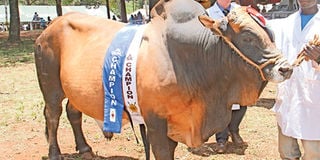Why Kitale is the home of champion bulls

Mike Nyongesa of ADC Nai Farm in Endebess handles their champion Borana bull, as Dr Hinner Koster inspects him during the judging process. The bull, according to Nyongesa east 50kg of special formulated feed, alongside grazing daily. PHOTO | MARTIN MUKANGU | NMG
What you need to know:
- The lucky bull was raised by the Kenya Seed Company’s Elgon Downs Farm in Kitale.
- At Elgon Downs, they let the animals graze most of the time, with the grass in the fields carefully attended to, especially through top-dressing.
- Mike Nyongesa, a feeds specialist at the ADC Nai Farm, points out that they offer their animals a mixture of maize meal, molasses, sunflower, oats and salt, providing a rich diet for the cattle, especially those reared for breeding purposes.
- Solomon Silenge of Suam Orchards notes that livestock should be kept in environs in which they are relaxed both physically and psychologically.
One of the highlights of last week’s Nairobi International Trade Fair was the First Lady Margaret Kenyatta buying a two-year-old supreme companion bull at Sh650,000.
The First Lady outdid all the other bidders, who included the President, to clinch the top prize at the handsome price.
The lucky bull was raised by the Kenya Seed Company’s Elgon Downs Farm in Kitale.
It weighed 650kg and is a cross of Boran and Simmental breeds, with the latter being a Swiss variety of the Fleckviehs.
From ADC Nai Farm came a stud bull named John, which won in the breeders’ category. The seven-year-old pure Boran animal weighed a tonne, and was bred in Endebess, on the slopes of Mt Elgon, by the seed producing farm.
Not far from the two enterprises in Kitale is Suam Orchards, another seed producing farm. It had three stout bulls of the Boran and Hereford, and Boran and Charolais crosses that gave the top contenders a run for their money.
So, how has Kitale managed to produce top bulls that routinely win in nearly all major livestock competitions they participate?
Hosea Sirma, the head of production at Elgon Downs, says feeding is among the most important of all the factors.
On their approximately 5,000-acre farm, which currently hosts up to 500 animals, mainly beef cattle breeds, they feed the cattle on pastures, cereals, seeds, maize stovers, and a variety of oil seeds such as sunflower, soya, canola, cotton, and safflower, among others.
“We further give the cattle mineral supplements and being premium seed producers, we ensure our pastures are of optimal quality,” says Sirma.
At Elgon Downs, they let the animals graze most of the time, with the grass in the fields carefully attended to, especially through top-dressing.
“Clean drinking water is usually always available for the cattle, and salt blocks for their licking is ever present in the field,” he says, adding what remains after the production of pasture seeds and the byproducts of the processes also go into feeding the cattle. There is also routine checking of the livestock for any pests and diseases.
AMPLE AND FAVOURABLE WEATHER CONDITIONS
Mike Nyongesa, a feeds specialist at the ADC Nai Farm, points out that they offer their animals a mixture of maize meal, molasses, sunflower, oats and salt, providing a rich diet for the cattle, especially those reared for breeding purposes.

Handlers try to restrain the two-year old bull from Simlaw's Elgon Downs Farm in Kitale, who won the supreme champion in this year's ASK Nairobi International Trade Fair. The bull was bought by First Lady Margaret Kenyatta at the auction. PHOTO | MARTIN MUKANGU | NMG
“Our champion bull, which won in this year’s breeders bull category, and other bulls on the farm, eat up to 50kg of this feed every day. That is 17kg in the morning, at midday and in the evening. This, is alongside their normal grazing,” says Nyongesa.
He adds that feeds and water should be in abundance and readily accessible to the livestock.
“Without water nearby, for instance, when thirsty, the cow will spend too much time looking for it at the expense of feeding.”
Solomon Silenge of Suam Orchards notes that livestock should be kept in environs in which they are relaxed both physically and psychologically.
“Minimise situations that tend to affect cattle such as noise which impairs their feeding habits.’
Besides feeds, according to the livestock experts, Kitale has good climate and rich soils, which facilitate cultivation of pastures, fodder and grass, and also has ample rainfall which is required by the plants to thrive.
“The environment and weather conditions in the region, especially Endebess, are also comfortable and favourable for thriving of the livestock,” says Sirma.
However, while the conditions are good for livestock breeding and production, it all boils down to an individual farm’s acquisition of proper livestock genetics, good management of the farm and feeding.
Dr Hinner Koster, a senior interbreed livestock expert and judge based in South Africa, notes when judging the animals, they check good body capacity, a balanced and structurally correct body shape, strong hind quarters and the animal should be well proportional from front to back.
“Age of the livestock is not necessarily a big determinant in this process. A young animal can effectively compete against an older one,” says Dr Koster, noting it is the reason why the two-year-old champion from Kenya Seed was declared the supreme champion against ADC Nai Farm’s Boran bull which was the breeding category champion, and weighed a lot more.





